Dutch researchers at the Amsterdam-based EYE Film Institute have discovered one of the oldest extant Hungarian films: A Munkászubbony/The Work Jacket, first shown on 12 January 1915. Lost for decades, The Work Jacket is one of the longest Hungarian silent films of the era. The film, directed by István Bródy, stars Gyula Hegedűs, one of the most important actors of his day in Hungary. We don't have any postcards of the film nor of Hegedűs in our celebration, but EFSP celebrates this wonderful news with postcards of 12 stars of the silent Hungarian cinema.
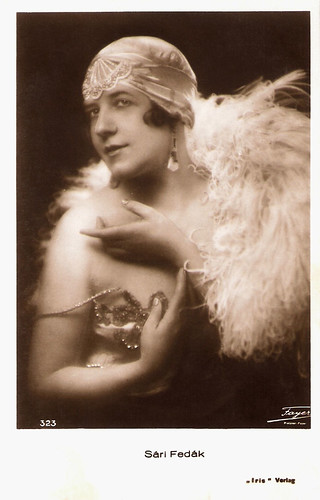
Austrian postcard by Iris Verlag, no. 323. Photo: Fayer.
Hungarian actress and singer Sári Fedák (1879-1955) was one of the most famous prima donnas of her time. The temperamental operetta and film star was mixed up in several scandals. In 1912, she made her film debut in the short comedy Gazdag ember kabátja/Rich man’s coat (Andor K. Kovács, 1912) based on a story by the famous Hungarian playwright and novelist Ferenc Molnár. The next year, she co-starred with Alfréd Deésy in Rablélek (1913), directed by Mihály Kertész who later became the famous Hollywood director Michael Curtiz.
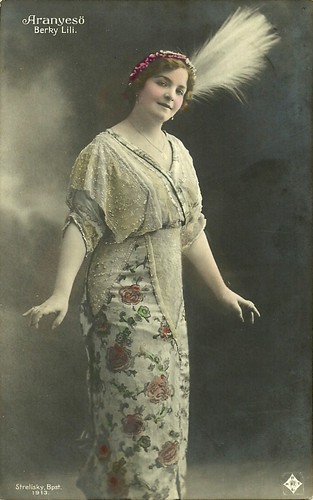
Hungarian postcard. Photo: Strelisky, Budapest, 1913. Lily Berky in the operetta Aranyesö, composed by Béla Zerkovitz and with a libretto by Adolf Mérei and Izor Béldia.
Lili Berky (1886–1958) was a Hungarian stage and screen actress, who starred in over 30 Hungarian silent films between 1913 and the late 1920s and played in an equal amount of Hungarian sound films, mainly in the 1930s and early 1940s. Berky's first big success was the silent drama Sárga csikó/The Yellow Foal (Félix Vanyl, 1913), co-starring Gyula Nagy and Victor Varconi. In 1917 she became the wife of Hungarian actor and comedian Gyula Gózon. They often performed together.
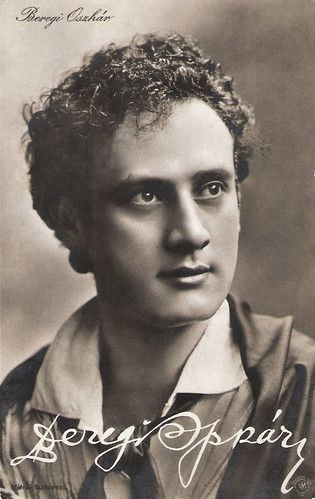
German postcard by NPG. Photo: Mátrai, Budapest.
Hungarian stage and film actor Oscar Beregi, Sr. (1876-1965) appeared in 27 European and American films between 1916 and 1953. He is best remembered as Dr. Baum in Fritz Lang’s Das Testament des Dr. Mabuse (1933). The sources differ about Beregi’s film debut in 1916. Was it with the lead role in the silent Hungarian production Mire megvénülünk/The time we get old (Ödön Uher ifj., 1916) or with the male lead in Hófehérke/Snowwhite (Márton Garas, 1916) with Ica von Lenkeffy? A year later he starred in the drama A Gólyakalifa/The Stork Caliph (Korda Sándor a.k.a. Alexander Korda, 1917), co-starring Gyula Bartos and Judit Bánky. It was the second film made by the legendary director-producer for his newly established Corvin Film company.
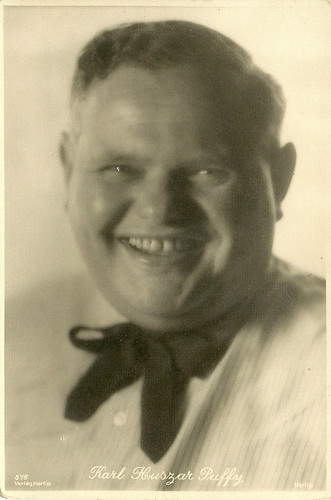
Vintage postcard by Verlag Hartiq, no. 576. Photo: Hartiq. Collection: Didier Hanson.
Fat Hungarian stage and film comedian Karl Huszár-Puffy (1884–1942 or 1943) was the most popular slapstick star of the Hungarian silent era. He started his film career as Károly Huszár in such silent shorts as Víg egyveleg, avagy Pufi és társai (Kornél Tábori, 1914) and Pufi cipöt vesz/Puffy buys shoes (Kornél Tábori, 1914). In these films he played a character called Pufi. It became his nickname and stage name. In 1917 he worked with director Michael Curtiz (then still Mihály Kertész) at Tavasz a télben/Spring in Winter (1917), and Az Ezredes/The Colonel (1917) with the young Béla Lugosi. That year he also worked with another famous director-to-be, Alexander Korda (as Korda Sándor), at Szent Péter esernyöje/St. Peter's Umbrella (1917) with Victor Varconi.
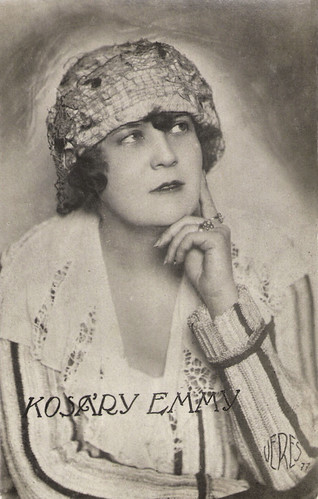
Hungarian postcard by Veres, no. 77.
Emmi Kosáry (1889-1964) was a Hungarian opera diva and operetta prima donna with a beautiful soprano voice. She also became a film actress, who worked in Hungary with the young Michael Curtiz. Kosáry was the wife of composer Ákos Buttykay. In 1917, Kosáry made her film debut in the silent film Tatárjárás/Tartar Invasion (1917) with Camilla von Hollay. The film was directed by Mihály Kertész who later became famous as Hollywood director Michael Curtiz.
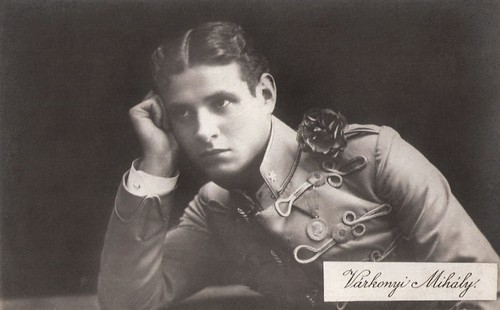
Hungarian postcard by B.J., Budapest.
Handsome Victor Varconi (1891–1976) was a highly successful matinee idol of the Hungarian-Austrian and German silent cinema in the 1910s and early 1920s. The young good-looking actor thrived for a time on the Transylvanian stage, where he played leads in such productions as Liliom at the Hungarian National Theatre in Budapest. His rising popularity as a matinee idol led to film roles, and he made his debut in Sárga csikó/Son of the Pusta (Félix Vanyl, 1913). Other of his silent Hungarian films were Bánk Bán (Mihály Kertész aka Michael Curtiz, 1914) based on the play by József Katona, Mágia/Magic (Sándor Korda aka Alexander Korda, 1917), Szent Péter esernyöje/St. Peter's Umbrella (Alexander Korda, 1917) and Fehér rózsa/White Rose (Alexander Korda, 1919) starring Maria Corda, the director’s wife. Unfortunately nearly all these early films got lost. Later Varconi was the first Hungarian actor to become a Hollywood star until the sound film completely altered the course of his career.
Hungary has had a notable cinema industry from the beginning of the 20th century, and Hungarians affected the film world both inside and outside the borders. William Fox (born Wilhelm Fuchs) founded Fox Studios, Alexander Korda (Sándor László Kellner) played a leading role in the Britain's film industry, and Adolph Zukor founded Paramount Pictures.
The story of the Hungarian Cinema begins in 1896, when the first screening of the films of the Lumiére brothers was held at 10 May in the cafe of the Royal Hotel of Budapest. In June of the same year, Arnold and Zsigmond Sziklai opened the first Hungarian cinema at the 41. Andrássy street, named the Okonograph.
The first Hungarian fiction film was A tánc/The Dance directed by Béla Zsitkovszky, made as an illustration to one of the shows of the Uránia Scientific Theatre, where Béla Zsitovszky, was the projectionist. Zsitovszky, originally an optician, shot the picture on the roof terrace of the theatre with renowned actors and ballerinas of the Operaház theatre. A tánc premiered on 30 April 1901.
According to Wikipedia, a characteristic style of early Hungarian cinema was the cinema sketch, a hybrid form of theatre and film. Each short projection was followed or interrupted by live stage actors, often acting their own characters from the screen. The genre inspired many prominent writers of the time, including Ferenc Molnár and Frigyes Karinthy. Comedians also used this form often to perform various jokes and scenes utilising its hybrid nature, one well-known performer being Gyula Gózon.
Mór Undergleider also started a professional journal on the subject of cinema, called Mozgófénykép Híradó (News of Moving Picture). The journal published articles of numerous renowned writers, theatrical directors, aestheticans and scientists about motion picture, including the pioneering film-theory articles of the 18-year-old Alexander Korda.
During 1919 March–August, under the short-lived Hungarian Soviet Republic, the Hungarian cinema industry was the first one to be nationalised fully. The journal Vörös film (Red film) was started to popularise the shift. A number of filmmakers welcomed the change, as the government provided protection against competing foreign films.
The Hungarian Soviet Republic was short-lived and the period of political instability left the sprouting Hungarian film industry in ruins. Directors Michael Curtiz, who shot a total of 38 films in Hungary, and Alexander Korda had left the country and made their careers abroad.
During the 1920s, foreign companies made use of the economical crisis in Hungary by gaining hold of nearly all of the country's theatres. American, French and Italian films were all over the screens, leaving little ground for immature Hungarian productions, and the few companies drifted towards bankruptcy.

German postcard by Ross Verlag, no. 1454/3, 1927-1928. Photo: Angelo Photos.
Hungarian actor Iván Petrovich (1894-1962) started his career as Svetislav Petrovic with silent Hungarian films and appeared till his death in nearly 100 European films. The handsome and elegant Petrovich worked on stage as a singer and started to appear in silent films. To his early work belong Hungarian films as A Napraforgós hölgy/The Sunflower Woman (Mihály Kertész, aka Michael Curtiz, 1918) starring Lucy Doraine, and Lengyelvér/Polish Blood (Béla Balogh, 1920).
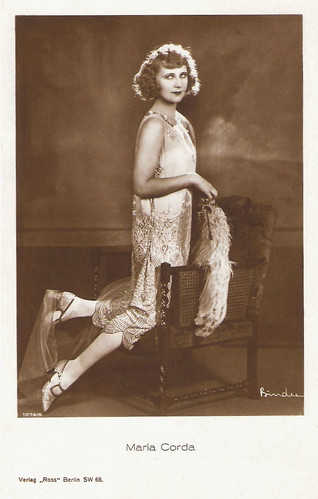
German postcard by Ross Verlag, no. 1074/6, 1927-1928. Photo: Alex Binder.
Hungarian Maria Corda (1898-1975) was an immensely popular star of the silent cinema of Austria and Germany. The pretty, blonde actress was a queen of the popular epic spectacles of the 1920s, which were often directed by her husband, Alexander Korda. She began her acting career in the theatres of Budapest in the early days of World War I. Soon after Hungary became an independent state she began to work in the film industry as well. As Antónia Farkas she made her first film appearance in Se ki, se be/Not In, or Out (Sándor Korda aka Alexander Korda, 1919). In 1919 she married her director, but she would always write her last name differently to differentiate herself from her husband. He featured her in Fehér rózsa/The White Rose (Alexander Korda, 1919), Ave Caesar! (Alexander Korda, 1919) and A 111-es/Number 111 (Alexander Korda, 1919). Then, she followed Korda when he journeyed to Vienna to join the Sascha Film Company.
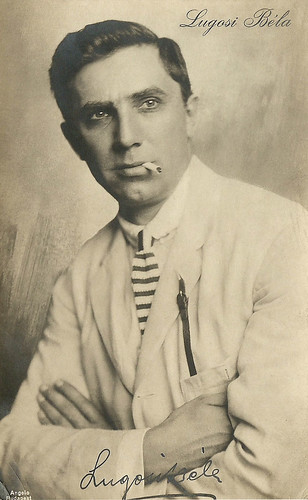
Hungarian postcard. Photo: Angelo, Budapest. Collection: Didier Hanson.
Hungarian actor Béla Lugosi (1882–1956) is best known as the vampire Count Dracula in the horror classic Dracula (1931). He started his film career in the silent Hungarian cinema and later also appeared in German silent films. In 1917 he made his film debut in Az ezredes/The Colonel (Mihály Kertész a.k.a. Michael Curtiz, 1917). In the next two years, Lugosi made 12 films in Hungary, credited as Arisztid Olt, including Nászdal/The Wedding March (Alfréd Deésy, 1917) and Lulu (Michael Curtiz, 1918). After the collapse of Béla Kun's Hungarian Soviet Republic in 1919, leftists and trade unionists became vulnerable. Due to his participation in the formation of an actors’ union, Lugosi was proscribed from acting and so had to leave his homeland.
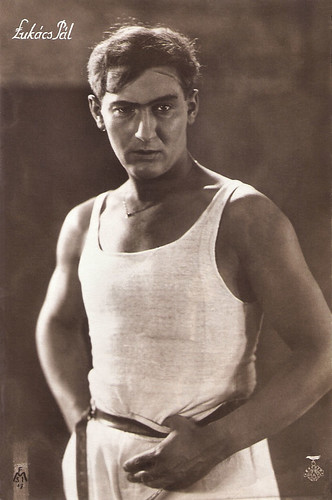
Hungarian postcard by FMSI, no.17. Photo: Korvin / Joe May Film.
Hollywood actor Paul Lukas (1891-1971) was born as born Pál Lukács in Budapest. In 1917, he made his film debut in Sphynx/Sphinx (Béla Balogh, 1918). Among his other Hungarian films are Udvari levegö/Song of the Heart (Béla Balogh, 1918) and Masamód/The Milliner (László Márkus, 1920) with Ica von Lenkeffy. He had a successful stage and film career in Hungary, Germany and Austria where he worked with Max Reinhardt. In 1927, he arrived in Hollywood.
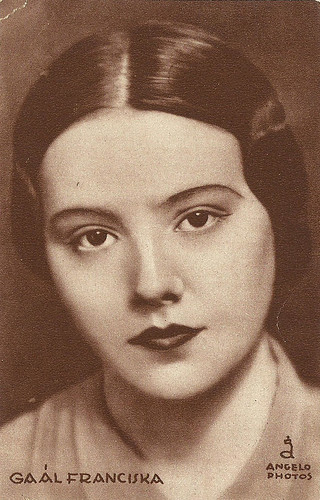
Hungarian postcard. Publisher: Globus, Budapest. Photo: Angelo Photos. Collection: Didier Hanson.
Popular Hungarian cabaret artist and theatrical actress Franciska Gaál (1904-1973) starred in several European films of the 1920s and 1930s. Her film debut in Hungary was the short silent film Az Egér/The Mouse (Lajos Gellért, 1921). Two other silent films followed, A cornevillei harangok/The bells of Corneville (Antal Forgács, 1921) and New-York express kábel/New York Express cable (Márton Garas, 1921). But after these films, she focused on the stage. Several plays were written especially for her, including A jó tündér (The Good Fairy, 1930) and Valaki (Violet, 1931) by Ferenc Molnár. She was thus a highly successful stage actress, when producer Joe Pasternak engaged her for Universal's European subsidiary Deutsche Universal. Later she went to Hollywood to star in Cecil B. DeMille's The Buccaneer (1938) and other films.
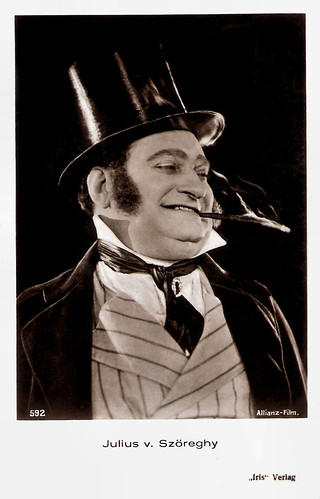
Austrian postcard by Iris Verlag, no. 592. Photo: Allianz Film.
Hungarian actor and film director Julius von Szöreghy (1883-1943) was one of the busiest supporting actors of the German and Austrian cinema in the second half of the 1920s. His film appearances began in 1913 under his own name Gyula Szöreghy. Among his silent Hungarian films are Mary Ann (Alexander Korda, 1918) starring Ica von Lenkeffy, and the drama Fehér rózsa/White Rose (Alexander Korda, 1919) starring María Corda. Fehér rózsa/White Rose was released by the state-owned Hungarian film industry during the Hungarian Soviet Republic, although production had begun before the regime came to power. He also played Sikes in Twist Olivér/Oliver Twist (Márton Garas, 1919), a Hungarian adaptation of the novel by Charles Dickens. In 1920, he moved to Vienna in Austria, and changed his name to Julius von Szöreghy.
Sources: Hungary Today, Wikipedia and IMDb.

Austrian postcard by Iris Verlag, no. 323. Photo: Fayer.
Hungarian actress and singer Sári Fedák (1879-1955) was one of the most famous prima donnas of her time. The temperamental operetta and film star was mixed up in several scandals. In 1912, she made her film debut in the short comedy Gazdag ember kabátja/Rich man’s coat (Andor K. Kovács, 1912) based on a story by the famous Hungarian playwright and novelist Ferenc Molnár. The next year, she co-starred with Alfréd Deésy in Rablélek (1913), directed by Mihály Kertész who later became the famous Hollywood director Michael Curtiz.

Hungarian postcard. Photo: Strelisky, Budapest, 1913. Lily Berky in the operetta Aranyesö, composed by Béla Zerkovitz and with a libretto by Adolf Mérei and Izor Béldia.
Lili Berky (1886–1958) was a Hungarian stage and screen actress, who starred in over 30 Hungarian silent films between 1913 and the late 1920s and played in an equal amount of Hungarian sound films, mainly in the 1930s and early 1940s. Berky's first big success was the silent drama Sárga csikó/The Yellow Foal (Félix Vanyl, 1913), co-starring Gyula Nagy and Victor Varconi. In 1917 she became the wife of Hungarian actor and comedian Gyula Gózon. They often performed together.

German postcard by NPG. Photo: Mátrai, Budapest.
Hungarian stage and film actor Oscar Beregi, Sr. (1876-1965) appeared in 27 European and American films between 1916 and 1953. He is best remembered as Dr. Baum in Fritz Lang’s Das Testament des Dr. Mabuse (1933). The sources differ about Beregi’s film debut in 1916. Was it with the lead role in the silent Hungarian production Mire megvénülünk/The time we get old (Ödön Uher ifj., 1916) or with the male lead in Hófehérke/Snowwhite (Márton Garas, 1916) with Ica von Lenkeffy? A year later he starred in the drama A Gólyakalifa/The Stork Caliph (Korda Sándor a.k.a. Alexander Korda, 1917), co-starring Gyula Bartos and Judit Bánky. It was the second film made by the legendary director-producer for his newly established Corvin Film company.

Vintage postcard by Verlag Hartiq, no. 576. Photo: Hartiq. Collection: Didier Hanson.
Fat Hungarian stage and film comedian Karl Huszár-Puffy (1884–1942 or 1943) was the most popular slapstick star of the Hungarian silent era. He started his film career as Károly Huszár in such silent shorts as Víg egyveleg, avagy Pufi és társai (Kornél Tábori, 1914) and Pufi cipöt vesz/Puffy buys shoes (Kornél Tábori, 1914). In these films he played a character called Pufi. It became his nickname and stage name. In 1917 he worked with director Michael Curtiz (then still Mihály Kertész) at Tavasz a télben/Spring in Winter (1917), and Az Ezredes/The Colonel (1917) with the young Béla Lugosi. That year he also worked with another famous director-to-be, Alexander Korda (as Korda Sándor), at Szent Péter esernyöje/St. Peter's Umbrella (1917) with Victor Varconi.

Hungarian postcard by Veres, no. 77.
Emmi Kosáry (1889-1964) was a Hungarian opera diva and operetta prima donna with a beautiful soprano voice. She also became a film actress, who worked in Hungary with the young Michael Curtiz. Kosáry was the wife of composer Ákos Buttykay. In 1917, Kosáry made her film debut in the silent film Tatárjárás/Tartar Invasion (1917) with Camilla von Hollay. The film was directed by Mihály Kertész who later became famous as Hollywood director Michael Curtiz.

Hungarian postcard by B.J., Budapest.
Handsome Victor Varconi (1891–1976) was a highly successful matinee idol of the Hungarian-Austrian and German silent cinema in the 1910s and early 1920s. The young good-looking actor thrived for a time on the Transylvanian stage, where he played leads in such productions as Liliom at the Hungarian National Theatre in Budapest. His rising popularity as a matinee idol led to film roles, and he made his debut in Sárga csikó/Son of the Pusta (Félix Vanyl, 1913). Other of his silent Hungarian films were Bánk Bán (Mihály Kertész aka Michael Curtiz, 1914) based on the play by József Katona, Mágia/Magic (Sándor Korda aka Alexander Korda, 1917), Szent Péter esernyöje/St. Peter's Umbrella (Alexander Korda, 1917) and Fehér rózsa/White Rose (Alexander Korda, 1919) starring Maria Corda, the director’s wife. Unfortunately nearly all these early films got lost. Later Varconi was the first Hungarian actor to become a Hollywood star until the sound film completely altered the course of his career.
The Hungarian silent cinema
Hungary has had a notable cinema industry from the beginning of the 20th century, and Hungarians affected the film world both inside and outside the borders. William Fox (born Wilhelm Fuchs) founded Fox Studios, Alexander Korda (Sándor László Kellner) played a leading role in the Britain's film industry, and Adolph Zukor founded Paramount Pictures.
The story of the Hungarian Cinema begins in 1896, when the first screening of the films of the Lumiére brothers was held at 10 May in the cafe of the Royal Hotel of Budapest. In June of the same year, Arnold and Zsigmond Sziklai opened the first Hungarian cinema at the 41. Andrássy street, named the Okonograph.
The first Hungarian fiction film was A tánc/The Dance directed by Béla Zsitkovszky, made as an illustration to one of the shows of the Uránia Scientific Theatre, where Béla Zsitovszky, was the projectionist. Zsitovszky, originally an optician, shot the picture on the roof terrace of the theatre with renowned actors and ballerinas of the Operaház theatre. A tánc premiered on 30 April 1901.
According to Wikipedia, a characteristic style of early Hungarian cinema was the cinema sketch, a hybrid form of theatre and film. Each short projection was followed or interrupted by live stage actors, often acting their own characters from the screen. The genre inspired many prominent writers of the time, including Ferenc Molnár and Frigyes Karinthy. Comedians also used this form often to perform various jokes and scenes utilising its hybrid nature, one well-known performer being Gyula Gózon.
Mór Undergleider also started a professional journal on the subject of cinema, called Mozgófénykép Híradó (News of Moving Picture). The journal published articles of numerous renowned writers, theatrical directors, aestheticans and scientists about motion picture, including the pioneering film-theory articles of the 18-year-old Alexander Korda.
During 1919 March–August, under the short-lived Hungarian Soviet Republic, the Hungarian cinema industry was the first one to be nationalised fully. The journal Vörös film (Red film) was started to popularise the shift. A number of filmmakers welcomed the change, as the government provided protection against competing foreign films.
The Hungarian Soviet Republic was short-lived and the period of political instability left the sprouting Hungarian film industry in ruins. Directors Michael Curtiz, who shot a total of 38 films in Hungary, and Alexander Korda had left the country and made their careers abroad.
During the 1920s, foreign companies made use of the economical crisis in Hungary by gaining hold of nearly all of the country's theatres. American, French and Italian films were all over the screens, leaving little ground for immature Hungarian productions, and the few companies drifted towards bankruptcy.

German postcard by Ross Verlag, no. 1454/3, 1927-1928. Photo: Angelo Photos.
Hungarian actor Iván Petrovich (1894-1962) started his career as Svetislav Petrovic with silent Hungarian films and appeared till his death in nearly 100 European films. The handsome and elegant Petrovich worked on stage as a singer and started to appear in silent films. To his early work belong Hungarian films as A Napraforgós hölgy/The Sunflower Woman (Mihály Kertész, aka Michael Curtiz, 1918) starring Lucy Doraine, and Lengyelvér/Polish Blood (Béla Balogh, 1920).

German postcard by Ross Verlag, no. 1074/6, 1927-1928. Photo: Alex Binder.
Hungarian Maria Corda (1898-1975) was an immensely popular star of the silent cinema of Austria and Germany. The pretty, blonde actress was a queen of the popular epic spectacles of the 1920s, which were often directed by her husband, Alexander Korda. She began her acting career in the theatres of Budapest in the early days of World War I. Soon after Hungary became an independent state she began to work in the film industry as well. As Antónia Farkas she made her first film appearance in Se ki, se be/Not In, or Out (Sándor Korda aka Alexander Korda, 1919). In 1919 she married her director, but she would always write her last name differently to differentiate herself from her husband. He featured her in Fehér rózsa/The White Rose (Alexander Korda, 1919), Ave Caesar! (Alexander Korda, 1919) and A 111-es/Number 111 (Alexander Korda, 1919). Then, she followed Korda when he journeyed to Vienna to join the Sascha Film Company.

Hungarian postcard. Photo: Angelo, Budapest. Collection: Didier Hanson.
Hungarian actor Béla Lugosi (1882–1956) is best known as the vampire Count Dracula in the horror classic Dracula (1931). He started his film career in the silent Hungarian cinema and later also appeared in German silent films. In 1917 he made his film debut in Az ezredes/The Colonel (Mihály Kertész a.k.a. Michael Curtiz, 1917). In the next two years, Lugosi made 12 films in Hungary, credited as Arisztid Olt, including Nászdal/The Wedding March (Alfréd Deésy, 1917) and Lulu (Michael Curtiz, 1918). After the collapse of Béla Kun's Hungarian Soviet Republic in 1919, leftists and trade unionists became vulnerable. Due to his participation in the formation of an actors’ union, Lugosi was proscribed from acting and so had to leave his homeland.

Hungarian postcard by FMSI, no.17. Photo: Korvin / Joe May Film.
Hollywood actor Paul Lukas (1891-1971) was born as born Pál Lukács in Budapest. In 1917, he made his film debut in Sphynx/Sphinx (Béla Balogh, 1918). Among his other Hungarian films are Udvari levegö/Song of the Heart (Béla Balogh, 1918) and Masamód/The Milliner (László Márkus, 1920) with Ica von Lenkeffy. He had a successful stage and film career in Hungary, Germany and Austria where he worked with Max Reinhardt. In 1927, he arrived in Hollywood.

Hungarian postcard. Publisher: Globus, Budapest. Photo: Angelo Photos. Collection: Didier Hanson.
Popular Hungarian cabaret artist and theatrical actress Franciska Gaál (1904-1973) starred in several European films of the 1920s and 1930s. Her film debut in Hungary was the short silent film Az Egér/The Mouse (Lajos Gellért, 1921). Two other silent films followed, A cornevillei harangok/The bells of Corneville (Antal Forgács, 1921) and New-York express kábel/New York Express cable (Márton Garas, 1921). But after these films, she focused on the stage. Several plays were written especially for her, including A jó tündér (The Good Fairy, 1930) and Valaki (Violet, 1931) by Ferenc Molnár. She was thus a highly successful stage actress, when producer Joe Pasternak engaged her for Universal's European subsidiary Deutsche Universal. Later she went to Hollywood to star in Cecil B. DeMille's The Buccaneer (1938) and other films.

Austrian postcard by Iris Verlag, no. 592. Photo: Allianz Film.
Hungarian actor and film director Julius von Szöreghy (1883-1943) was one of the busiest supporting actors of the German and Austrian cinema in the second half of the 1920s. His film appearances began in 1913 under his own name Gyula Szöreghy. Among his silent Hungarian films are Mary Ann (Alexander Korda, 1918) starring Ica von Lenkeffy, and the drama Fehér rózsa/White Rose (Alexander Korda, 1919) starring María Corda. Fehér rózsa/White Rose was released by the state-owned Hungarian film industry during the Hungarian Soviet Republic, although production had begun before the regime came to power. He also played Sikes in Twist Olivér/Oliver Twist (Márton Garas, 1919), a Hungarian adaptation of the novel by Charles Dickens. In 1920, he moved to Vienna in Austria, and changed his name to Julius von Szöreghy.
Sources: Hungary Today, Wikipedia and IMDb.
No comments:
Post a Comment